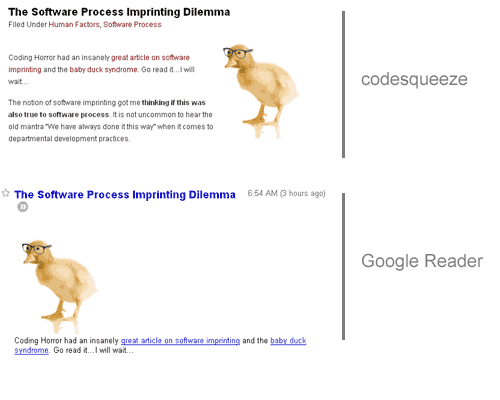Can XHTML Strict Ever Be A Practical Standard?
Filed Under UsabilityWhenever possible my web applications comply to the XHTML Strict standard; however, the ever growing want for Web 2.0 mashup applications forces developers to create content for multiple platforms such as PDAs, RSS readers, and multiple web browsers. It pains me when I need to enforce styles across platforms thus forcing me to downgrade from Strict to Transitional.
For example, in a recent post I included a picture of a baby duck wearing glasses. In my layout I wanted it to float right. Easy enough, I just place a class on it and define my style in the CSS. It looks great on the page and is Strict compliant, but then it renders incorrectly in feed readers such as Google Reader.

In this example, I don’t give a hoot how the baby duck renders in Google Reader, but what if I did? I would be reduced to make the following change:
changed to
<img src="…" style="float:right;" />
As a result, this is not XHTML Strict complaint and I would have to mark the entire page Transitional. Perhaps this sounds silly, but as data is passed more freely between multiple systems this problem will only get worse. As a result a decision must be made between two choices:
- Keep data and display decoupled, but surrender render details on other systems
- Embed styles and render how you want, but surrender decoupling
Does it need to be this black and white? Can a happy medium be meet with a new standard? For example, what would happen if the next version of RSS allowed you to add the location of an associated CSS file? Would this solve the problem or would it create more problems?
Shout back…



